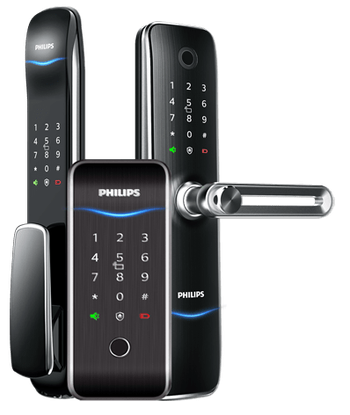
The emergence of the smart lock has solved most of the mechanical drawbacks, which makes us not only enter a key-free era but greatly improve safety. Compared with the traditional mechanical lock, the smart lock is a kind of composite lock that combines with biological recognition technology and makes user recognition, lock safety and management more intelligent. With the development of intelligent technology, the smart lock is gradually innovating and progressing. With its high safety and convenience, it solves the inconvenience brought by the traditional lock, which makes it becomes a better choice when users decide to change their previous locks. Thus, this article could give some reasons why the smart lock becomes safer than the traditional mechanical lock.
Metal escutcheon design
Philips smart lock adopts high-strength alloyed materials like zinc alloy and aluminum alloy. Its enclosure protection class conforms to IP52 degree in GB/T 4208-2017. In other words, it could withstand a high-strength impact of 2.62J under the pressure of 110N, which has strong anti-collision and anti-destructive capabilities. Besides, featured with a hidden C-grade lock cylinder, Philips smart lock enables to prevent the lock from unlocking by violence through the cylinder, which double increases the anti-theft performance.
Die-casting integrated mortise
The most important function of a lock is to provide enough sense of safety for the family. Besides, one of the essential components to ensure lock safety is the mortise of a lock. Both Philips smart lock mortise and handle adopt a die-casting integrated technology with strong anti-vandal capability. Its latch bolt is made of 304 stainless steel or the same mental material. The main latch bolt could retract less than 5 mm under the impact brought by the 3000N of axial static pressure. It could still be used normally under the 6000N of the sideways static pressure. Thus, Philips smart lock has strong anti-prying, anti-pull, anti-sawing, and anti-drilling capabilities.
Multiple security encryption technologies
Insufficient data encryption would lead to serious security risks. For example, the data of door unlocking instructions would be stolen or the server would be attacked which causes PIN code leaking. While a qualified smart lock should have an encrypted chip, encrypted data and an authorized Cloud server. Philips smart lock employs multiple security encryption technologies included encrypted storage of the PIN code and APP data to avoid hackers invading the system and stealing data.
Anti-black box security settings
In nature, the small black box is a kind of Tesla coil, which could generate strong electromagnetic pulses to damage the surrounding electronic devices. While Philips smart lock PCBA design could shield the electromagnetic field generated by the Tesla coil. It could also avoid some abnormal instructions like restoring factory settings and man-made automatic unlocking under the interference of the Tesla coil.
To sum up, a safe and reliable smart lock should have a safety guarantee from the inside and out. Philips smart lock not only has anti-collision, anti-prying and anti-vandal capabilities but protects user’s data safety and against little black box lock-picking technology. As the first entrance of smart home protection, the smart lock has become a life necessity not matter of its safety or convenience. Philips smart lock combines with multiple safety and intelligence, which makes life easier and protects your home in all respects.
